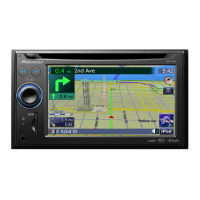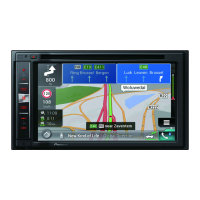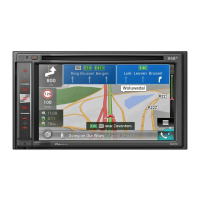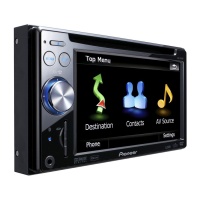
Do you have a question about the Pioneer AVIC-F920BT and is the answer not in the manual?
| Geocaching (GPS stash hunt) | Yes |
|---|---|
| Marine (chartplotters, sounders) | No |
| Map view options | 2D/3D |
| GPS receiver | L1, C/Acode GPS, SPS |
| Power requirements | 14.4 V DC |
| Form factor | Plug-in |
| Product color | Black |
| Channels quantity | 30 channels |
| Display diagonal | 6.1 \ |
| Native aspect ratio | 16:9 |
| Compatible memory cards | microSDHC |
| Bluetooth version | 2.0+EDR |
| USB 2.0 ports quantity | 1 |
| Audio formats supported | AAC, MP3, WAV, WMA |
| Image formats supported | JPG |
| Storage temperature (T-T) | -20 - 80 °C |
| Operating temperature (T-T) | -10 - 60 °C |
| Depth | 165 mm |
|---|---|
| Width | 178 mm |
| Height | 100 mm |
| Weight | 2510 g |
Provides an overview of the manual's structure, how to use it, and key conventions.
Explains how to find operation procedures, understand manual conventions, and defines key terms.
Details formatting and symbols used for consistent understanding of the manual's content.
Explains specific terminology like "Front Display", "Video image", and "External storage device".
Identifies and explains the main parts and buttons of the navigation system.
Guides on how to adjust the angle of the LCD panel for optimal viewing.
Instructions for inserting and removing discs from the drive slot.
Details the process for inserting and removing SD memory cards.
Explains how to safely connect and disconnect USB storage devices.
Provides steps for connecting and disconnecting an iPod for media playback.
Outlines the complete process from system startup to shutdown.
Guides through initial setup steps, including language selection.
Describes the standard procedure for starting the navigation system.
Illustrates how to navigate between different menu screens using buttons like HOME and MODE.
Details functions accessible from menus like Destination, Phone, AV Source, and Settings.
Explains how to create shortcuts for quick access to frequently used menu items.
Step-by-step guide on how to register menu items into the shortcut menu.
Instructions on how to remove items from the shortcut menu.
Explains how to navigate and interact with list displays like Points of Interest (POI).
Details how to use the virtual keyboard for text input.
Explains how to interpret information displayed on the map screen, including indicators and points.
Covers map scale adjustment and orientation switching.
Instructions on how to pan the map to view different areas.
Details how to customize the Quick Access menu for faster operations.
Explains how to switch between 2D, 3D, Street, and Rear View modes.
Describes how to view the Eco Graph to assess driving efficiency and fuel mileage.
Explains the Eco Drive Level feature and its visual feedback on driving eco-friendliness.
Details the alert system for sudden acceleration or harsh starts.
Outlines the standard steps for setting a route to a destination.
Guides on how to find locations using address details like street, city, or postcode.
Covers how to find Points of Interest like gas stations or restaurants.
Instructions for finding Points of Interest located in the vicinity.
Guides on selecting destinations from a list of frequently visited locations.
Details how to find locations using latitude and longitude.
Guides on setting the final route after confirming the destination.
Explains how to view and select from alternative route options.
Shows how to view a summary of the current route and its details.
Details how to adjust route calculation preferences like road type and restrictions.
Instructions for adding, deleting, and sorting waypoints on a route.
Explains how to reorder waypoints for route recalculation.
Guides on how to stop the current route guidance.
Explains how to save frequently used locations for easy access.
Covers how to modify saved location details.
Instructions on removing locations from the Favourites list.
Explains how to transfer Favourites data to/from an SD card.
Guides on how to clear past search history entries.
How to view a comprehensive list of traffic incidents.
Guides on viewing traffic data specific to the current route.
Details how the system automatically finds detours for traffic jams.
Explains how the system alerts about and reroutes for traffic jams.
How to choose which types of traffic information are shown.
Guides on manually choosing a preferred traffic information provider.
Covers requirements and profiles for Bluetooth-enabled devices.
Explains the process of pairing Bluetooth devices with the system.
Steps to find and register nearby Bluetooth devices.
Guides on initiating pairing from the Bluetooth device itself.
How to connect a specific Bluetooth device if it's not found automatically.
Instructions on removing paired Bluetooth devices.
Explains how to manually connect a previously paired device.
How to set a preferred device for automatic connection.
How to access the phone interface after connecting a mobile device.
Covers various methods for initiating phone calls, including direct dialling.
Guides on selecting and calling contacts from the transferred phone book.
How to call numbers from the recent call history.
Covers how the system handles incoming calls.
Guides on how to copy phone book entries from a mobile phone.
Instructions for removing contacts from the phone book.
Covers settings like device name and password for Bluetooth.
How to configure the system to answer calls automatically.
Guides on how to erase phone book and call history data.
General notes and tips for using the hands-free phoning feature.
How to access the screen for controlling audio/video sources.
Guides on choosing different audio/video sources like FM radio or iPod.
Explains how to navigate and interact with media list displays.
How to toggle between the main AV screen and media lists.
Details on how to choose specific items from media lists.
How to navigate back to the previous screen.
Steps to begin using the FM radio function.
Explains the indicators and information displayed on the FM radio screen.
How to control the radio using on-screen buttons.
Guides on saving and retrieving favorite radio stations.
How to view text information broadcast by FM stations.
Accesses various radio functions like BSM and tuning options.
Automatic storage of strongest FM stations via BSM.
How to use local seek tuning for better reception.
How to filter stations for regional broadcasts using AF.
Guides on finding stations based on program type (PTY).
Explains how to enable automatic reception of traffic announcements (TA).
How the system automatically retunes to better signals using AF.
How to switch to news broadcasts from any station.
Explains the meaning of TRFC and NEWS indicators.
Steps to begin using the AM radio function.
Explains the indicators on the AM radio display.
How to control the AM radio using on-screen buttons.
Guides on saving and retrieving favorite AM radio stations.
Accesses AM radio functions like BSM and local tuning.
Automatic storage of strongest AM stations via BSM.
How to use local seek tuning for better AM reception.
Steps to begin playing audio CDs.
Explains the indicators and information displayed during CD playback.
How to control CD playback using on-screen buttons.
Accesses CD playback functions like repeat, shuffle, and scan.
Steps to begin playing music files from discs.
Explains the indicators for music file playback.
How to control music file playback using on-screen buttons.
Accesses music file playback functions like repeat and shuffle.
Steps to begin playing DVD-Video discs.
Explains the indicators and information displayed during DVD playback.
How to control DVD playback using on-screen buttons.
Guides on finding specific scenes and starting playback at a chosen time.
How to navigate and use the DVD's interactive menu.
Allows direct input of numerical commands during DVD playback.
How to advance playback one frame at a time during pause.
Guides on how to play back video at a reduced speed.
Accesses DVD playback functions like repeat and audio output selection.
Steps to begin playing DivX video files.
Explains the indicators and information displayed during DivX playback.
How to control DivX playback using on-screen buttons.
Guides on finding specific scenes and starting playback at a chosen time.
Accesses DivX playback functions like repeat and screen size.
How to access the settings for DVD and DivX playback.
How to set restrictions for adult or violent content.
Configures the system to automatically start playback from the first title.
How to select whether to display external DivX subtitles.
Steps to begin playing music files from USB or SD devices.
Explains the indicators and information for USB/SD music playback.
How to control music file playback from USB/SD.
Accesses music file playback functions like repeat and shuffle for USB/SD.
Steps to begin playing video files from USB or SD devices.
Explains the indicators and information for USB/SD video playback.
How to control video file playback from USB/SD.
Guides on finding specific scenes and starting playback at a chosen time for video files.
Accesses video playback functions like repeat and screen size for USB/SD.
Steps to begin playing video content from a connected iPod.
How to filter and find specific media on an iPod using lists.
Explains how to control iPod functions directly from the iPod.
How to play playlists created with the MusicSphere application.
How to control iPod playback (music/video) using on-screen buttons.
Accesses iPod playback functions like repeat, shuffle, and audiobook speed.
Steps to begin using the Bluetooth audio player.
Explains the indicators and information during Bluetooth audio playback.
How to control Bluetooth audio playback using on-screen buttons.
Accesses Bluetooth audio playback functions like repeat and shuffle.
Explains the indicators for AV input sources.
How to display video from external input 1.
How to display video from external input 2.
How to control AV input sources using on-screen buttons.
Explains the indicators for external unit operations.
How to control external units via on-screen buttons.
How to access the main menu for navigation system settings.
Verifies correct wiring connections for system operation.
Displays information about vehicle sensors and driving data.
How to delete learned sensor and driving status data.
Guides on entering fuel data to estimate driving costs.
How to activate and review logged driving routes.
How to save and set your home address for easy routing.
Adjusts the vehicle's current position and direction on the map.
Customizes Eco Score, Eco Drive Level, and Rapid Start alerts.
How to access the main menu for map display settings.
Enables city map display in metropolitan areas at specific scales.
Displays a graphic in areas without city map data.
Controls the visibility of speed limits on the map.
Selects whether to show traffic incident icons on the map.
Controls the display of the Bluetooth connection status icon.
Selects whether to show the current street name on the map.
Controls the visibility of Favourites icons on the map.
Enables display of 3D landmarks on the map in 3D View mode.
Selects whether to display visual guidance cues on the map.
Controls the display of the Eco-Meter for fuel consumption.
Selects whether to show icons for surrounding Points of Interest.
Guides on selecting and displaying predefined Points of Interest icons.
How to display custom POI icons loaded from an SD card.
Selects different screen display types for navigation guidance.
Configures automatic map color switching based on time.
Allows selection of road colors (red or blue).
Controls automatic switching to navigation screen during AV playback.
Customizes the items displayed in the Quick Access menu.
How to access the main menu for system-wide settings.
Adjusts regional preferences like language and units.
Instructions for installing TTS files for street name pronunciation.
Adjusts the system clock and time difference settings.
Sets display units for distance and speed.
Adjusts volumes for navigation guidance and phone calls.
How to change the startup image from a list.
Guides on importing custom splash screens from an SD card.
Configures the system to display the rear view camera image.
Calibrates touch screen response for accurate input.
Customizes the color of the unit's illumination.
Displays system software and component version details.
Chooses the video source to be output to the rear display.
Allows adjustment of brightness, contrast, color, and dimmer for the display.
How to access the main menu for AV system settings.
Selects display modes (Full, Cinema, Zoom, Normal) for video.
Configures the rear speaker output for full-range or subwoofer.
Controls when AV source volume is muted or attenuated.
Sets the level of volume muting or attenuation.
How to access the main menu for AV sound settings.
Adjusts front/rear and left/right speaker balance for ideal sound.
Accesses the equalizer settings for sound customization.
Compensates for low-frequency deficiencies at low volumes.
Controls the subwoofer output mechanism.
Activates the high pass filter to exclude low frequencies from speakers.
Adjusts volume levels for different sources to prevent drastic changes.
Boosts bass sounds to compensate for driving noise.
Selects sound stage effects like Music Studio or Dynamic Theatre.
Imports settings from utility program via SD card.
Limits available functions while the vehicle is in motion.
Turns off the display backlight without stopping voice guidance.
Safety precautions and warnings for voice operation.
Overview of voice recognition technology and capabilities.
Outlines the basic steps involved in using voice commands.
How to activate the voice command interface.
Guides on performing voice commands for navigation.
Step-by-step voice commands to search for addresses.
Voice commands to find nearby Points of Interest.
Voice commands to make calls from the phone contacts.
Lists recognized voice commands for various functions.
Specific voice commands for making and managing phone calls.
Advice for ensuring accurate voice command recognition.
How to set a password to prevent unauthorized use.
Explains methods to reset the system to its original state.
Details which settings are cleared based on the reset method used.
Instructions to restore the system to factory default settings.
Guides on selecting specific items to reset.
Provides solutions for common navigation system problems.
Explains system messages and suggested corrective actions.
Explains how GPS and dead reckoning work for vehicle positioning.
Addresses situations where positioning accuracy might be compromised.
Lists factors that can lead to inaccuracies in vehicle positioning.
Provides details on how the system determines routes based on map data and rules.
Basic precautions for handling optical discs.
Lists the types of discs compatible with the unit.
Details on WMA file format compatibility.
Details on WAV file format compatibility.
Details on AAC file format compatibility.
Details on DivX file format, profile, audio codec, and image/file size limits.
Lists compatibility for various video file extensions and codecs.
Explains the Bluetooth wireless technology and its specifications.
Important CAUTIONary notes for connecting iPods.
Guidelines for handling and maintaining the LCD screen.
Overviews of the Destination and Phone menus for quick reference.
Lists pages related to the main Settings Menu.
Lists pages related to the Navi Settings menu.
Lists pages related to System Settings.
Lists pages related to Map Settings.
Lists pages related to AV System Settings.
Lists pages related to AV Sound Settings.
Lists pages related to Bluetooth Settings.
Definitions of technical terms used in the manual.
Explains embedded track information in MP3 files.
Standard for DVD/CD-ROM folder and file logic.
Audio compression standard from MPEG.
Standard for video image compression.
Ability to choose different audio tracks or languages.
Ability to choose from multiple subtitle languages.
How to restrict playback of violent or adult-oriented scenes on DVDs.
The process of determining the ideal route to a destination.
Logs recorded routes for later review or complex route navigation.
Navigation voice directions provided during guidance.
Technical specifications for the navigation system hardware.











